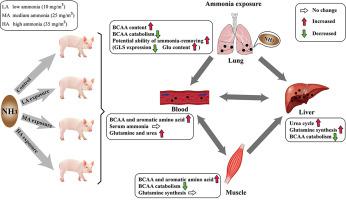Animal Nutrition ( IF 6.1 ) Pub Date : 2021-09-21 , DOI: 10.1016/j.aninu.2021.04.004 Shanlong Tang 1 , Chang Yin 1 , Jingjing Xie 1 , Jinglin Jiao 1 , Liang Chen 1 , Lei Liu 1 , Sheng Zhang 2 , Hongfu Zhang 1

|
Aerial ammonia exposure leads to tissue damage and metabolic dysfunction. However, it is unclear how different organs are coordinated to defend against aerial ammonia exposure. Twenty-four pigs were randomly divided into 4 groups, exposed to 0, 10, 25 or 35 mg/m3 ammonia respectively for 25 d. After above 25 mg/m3 ammonia exposure, decreased aspartate (P = 0.016), glutamate (P = 0.030) and increased ornithine (P = 0.002) were found in the ammonia-removing liver, and after high ammonia (35 mg/m3) exposure, glutamine synthetase (GS) expression was increased (P = 0.012). An increased glutamate (P = 0.004) and decreased glutaminase (GLS) expression (P = 0.083) were observed in the lungs after high ammonia exposure. There was also an increasing trend of glutamine in the kidneys after high ammonia exposure (P = 0.066). For branched-chain amino acid (BCAA) catabolism, high ammonia exposure increased BCAA content in both the lungs and muscle (P < 0.05), whereas below 25 mg/m3 ammonia exposure increased BCAA only in the lungs (P < 0.05). The expression of BCAA transaminase (BCAT1/2) and dehydrogenase complex (BCKDHA/B and DBT) were inhibited to a varying degree in the liver, lungs and muscle after above 25 mg/m3 ammonia exposure, especially high ammonia exposure. The expression of BCKDH complex and glutamate-glutamine metabolism-related genes were highly expressed in the liver, followed by the lungs and muscle (P < 0.01), whereas the BCAT2 expression was highest in the lungs (P = 0.002). Altogether, low ammonia exposure sufficed to evoke the urea cycle to detoxify ammonia in the liver. The process of ammonia removal in the liver and potential ability of the lungs to detoxify ammonia were enhanced with increasing ammonia. Furthermore, high ammonia exposure impaired the BCAA catabolism and decreased the transcripts of the BCAA catabolism-related enzymes, resulting in high BCAA content in extrahepatic tissues. Therefore, with aerial ammonia increasing, an increased urea cycle and glutamine synthesis were ammonia defensive strategies, and high ammonia exposure impaired the BCAA catabolism.
中文翻译:

空气氨暴露引起生长猪器官间氨处理和支链氨基酸分解代谢的扰动
空气中的氨暴露会导致组织损伤和代谢功能障碍。然而,尚不清楚不同器官如何协调以抵御空气中的氨暴露。24头猪随机分为4组,分别接触0、10、25或35mg/m 3氨水25天。在氨暴露超过 25 mg/m 3后, 在除氨肝脏中发现天冬氨酸减少 ( P = 0.016)、谷氨酸 ( P = 0.030) 和鸟氨酸增加 ( P = 0.002),而在高氨暴露(35 mg/m 3)暴露后,谷氨酰胺合成酶(GS)表达增加(P =0.012)。增加的谷氨酸 ( P = 0.004) 和谷氨酰胺酶 ( GLS ) 表达降低( P = 0.083) 在高氨暴露后的肺中观察到。高氨暴露后肾脏中的谷氨酰胺也有增加的趋势(P = 0.066)。对于支链氨基酸 (BCAA) 分解代谢,高氨暴露会增加肺和肌肉中的 BCAA 含量 ( P < 0.05),而低于 25 mg/m 3 的氨暴露仅增加肺中的 BCAA ( P < 0.05)。BCAA转氨酶( BCAT1/2 )和脱氢酶复合物( BCKDHA/B和DBT)的表达) 在超过 25 mg/m 3氨暴露后,尤其是高氨暴露后,在肝脏、肺和肌肉中受到不同程度的抑制。的表达BCKDH复杂和谷氨酸-谷氨酰胺代谢相关基因在肝中高度表达,其次是肺和肌肉(P <0.01),而BCAT2表达在肺中最高(P = 0.002)。总而言之,低氨暴露足以引起尿素循环以解毒肝脏中的氨。随着氨的增加,肝脏中氨的去除过程和肺解毒氨的潜在能力增强。此外,高氨暴露会损害 BCAA 分解代谢并减少 BCAA 分解代谢相关酶的转录,导致肝外组织中 BCAA 含量高。因此,随着空气中氨的增加,尿素循环和谷氨酰胺合成的增加是氨防御策略,而高氨暴露会损害支链氨基酸的分解代谢。











































 京公网安备 11010802027423号
京公网安备 11010802027423号